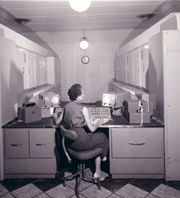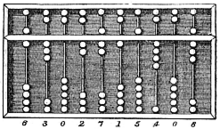Pre-twentieth century
Devices have been used to aid computation for thousands of years, mostly using
one-to-one correspondence with
fingers. The earliest counting device was probably a form of
tally stick. Later record keeping aids throughout the
Fertile Crescent
included calculi (clay spheres, cones, etc.) which represented counts
of items, probably livestock or grains, sealed in hollow unbaked clay
containers.
[3][4] The use of
counting rods is one example.
The Chinese
Suanpan (算盘) (the number represented on this abacus is 6,302,715,408)
The
abacus was initially used for arithmetic tasks. The
Roman abacus was developed from devices used in
Babylonia as early as 2400 BC. Since then, many other forms of reckoning boards or tables have been invented. In a medieval European
counting house,
a checkered cloth would be placed on a table, and markers moved around
on it according to certain rules, as an aid to calculating sums of
money.
The ancient Greek-designed
Antikythera mechanism, dating between 150 and 100 BC, is the world's oldest analog computer.
The
Antikythera mechanism is believed to be the earliest mechanical analog "computer", according to
Derek J. de Solla Price.
[5] It was designed to calculate astronomical positions. It was discovered in 1901 in the
Antikythera wreck off the Greek island of
Antikythera, between
Kythera and
Crete, and has been dated to
circa
100 BC. Devices of a level of complexity comparable to that of the
Antikythera mechanism would not reappear until a thousand years later.
Many mechanical aids to calculation and measurement were constructed for astronomical and navigation use. The
planisphere was a
star chart invented by Abū Rayhān al-Bīrūnī in the early 11th century.
[6] The
astrolabe was invented in the
Hellenistic world in either the 1st or 2nd centuries BC and is often attributed to
Hipparchus. A combination of the planisphere and
dioptra, the astrolabe was effectively an analog computer capable of working out several different kinds of problems in
spherical astronomy. An astrolabe incorporating a mechanical
calendar computer
[7][8] and
gear-wheels was invented by Abi Bakr of
Isfahan,
Persia in 1235.
[9] Abū Rayhān al-Bīrūnī invented the first mechanical geared
lunisolar calendar astrolabe,
[10] an early fixed-
wired knowledge processing
machine[11] with a
gear train and gear-wheels,
[12] circa 1000 AD.
The
sector,
a calculating instrument used for solving problems in proportion,
trigonometry, multiplication and division, and for various functions,
such as squares and cube roots, was developed in the late 16th century
and found application in gunnery, surveying and navigation.
The
planimeter was a manual instrument to calculate the area of a closed figure by tracing over it with a mechanical linkage.
The
slide rule was invented around 1620–1630, shortly after the publication of the concept of the
logarithm.
It is a hand-operated analog computer for doing multiplication and
division. As slide rule development progressed, added scales provided
reciprocals, squares and square roots, cubes and cube roots, as well as
transcendental functions such as logarithms and exponentials, circular and
hyperbolic trigonometry and other
functions.
Aviation is one of the few fields where slide rules are still in
widespread use, particularly for solving time–distance problems in light
aircraft. To save space and for ease of reading, these are typically
circular devices rather than the classic linear slide rule shape. A
popular example is the
E6B.
In the 1770s
Pierre Jaquet-Droz, a Swiss
watchmaker, built a mechanical doll (
automata)
that could write holding a quill pen. By switching the number and order
of its internal wheels different letters, and hence different messages,
could be produced. In effect, it could be mechanically "programmed" to
read instructions. Along with two other complex machines, the doll is at
the Musée d'Art et d'Histoire of
Neuchâtel,
Switzerland, and still operates.
[13]
The
tide-predicting machine invented by
Sir William Thomson
in 1872 was of great utility to navigation in shallow waters. It used a
system of pulleys and wires to automatically calculate predicted tide
levels for a set period at a particular location.
The
differential analyser, a mechanical analog computer designed to solve
differential equations by
integration, used wheel-and-disc mechanisms to perform the integration. In 1876
Lord Kelvin
had already discussed the possible construction of such calculators,
but he had been stymied by the limited output torque of the
ball-and-disk integrators.
[14] In a differential analyzer, the output of one integrator drove the input of the next integrator, or a graphing output. The
torque amplifier was the advance that allowed these machines to work. Starting in the 1920s,
Vannevar Bush and others developed mechanical differential analyzers.









